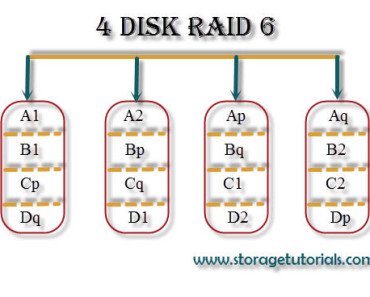When it comes to comparing RAID 5 vs RAID 6, then we have to consider a few important things like cost, no. of disks, data protection, etc.
If you are in a hurry, here is the summary of the differences between RAID 5 & RAID 6:
- RAID 5 uses one parity block to protect against the failure of one hard drive, while RAID 6 uses two parity blocks to protect against the failure of two hard drives.
- RAID 6 requires at least 4 hard drives, while RAID 5 requires a minimum of 3.
- RAID 5 can provide faster read and write speeds for large files, while RAID 6 is better at handling small files and random I/O.
- RAID 6 provides higher data protection than RAID 5 and can withstand the failure of two hard drives. However, RAID 6 is generally more expensive to set up due to the additional hard drives required for the extra parity blocks.
- RAID 6 is more costly than RAID 5 as it requires more disks.
RAID 5 vs RAID 6: Which One Should You Choose for Your Storage Needs?
When it comes to storage solutions, there are a variety of options available, but two of the most popular are RAID 5 and RAID 6. Both are designed to provide high levels of data protection and performance, but they have some key differences that can make one a better choice for certain scenarios.
In this article, we’ll compare RAID 5 vs RAID 6 and help you determine which one is best for your needs.
Table of Contents
Introduction
RAID, or Redundant Array of Independent Disks, is a data storage technology that uses multiple hard drives to improve data protection and performance. There are several different types of RAID like RAID 10, RAID 01, RAID 6, etc. each with its strengths and weaknesses.
RAID 5 and RAID 6 are two of the most popular options, and they both use a similar approach to data protection. However, there are some key differences between the two that can make one a better choice depending on your needs.
First of all, let’s understand what is RAID 5 and RAID 6.
What is RAID 5?
RAID 5 is a type of RAID that uses block-level striping with distributed parity. This means that data is spread across multiple hard drives, and each drive contains parity information that can be used to reconstruct data in the event of a drive failure.
With RAID 5, you need at least 3 hard drives to set up the array, and the total capacity of the array is equal to the sum of the capacities of all the drives, minus one.
If you want to calculate the capacity, fault tolerance, etc., use the RAID 5 Calculator.
What is RAID 6?
RAID 6 is similar to RAID 5, but it adds an additional level of redundancy. With RAID 6, data is also spread across multiple hard drives, but there are two sets of parity information that can be used to reconstruct data in the event of 2 drive failures.
This means that RAID 6 can withstand the failure of up to two drives without losing any data. To set up a RAID 6 array, you need at least 4 hard disks, and the total capacity of the array is equal to the sum of the capacities of all the drives, minus two.
RAID 5 vs RAID 6: Key Differences
While RAID 5 and RAID 6 are similar in many ways, there are some key differences between the two that can make one a better choice depending on your needs.
Let’s take a look at some of the most important factors to consider when choosing between RAID 5 and RAID 6.
Data Protection
One of the primary reasons to use RAID is to protect your data in the event of a drive failure. RAID 5 provides a good level of protection, as it can withstand the failure of one drive without losing any data.
However, if a second drive fails before the array can be rebuilt, you will lose all the data on the array.
RAID 6, on the other hand, can withstand the failure of up to two drives without losing any data. This makes RAID 6 a better choice if you have very important data that needs to be protected at all costs.
Performance
Another key factor to consider when choosing between RAID 5 and RAID 6 is performance.
In general, RAID 5 provides better performance than RAID 6, as it requires less overhead to maintain the parity information.
However, this performance advantage can be offset if you have a lot of small files, as the parity calculations required for RAID 5 can slow down performance for random I/O.
RAID 6 has to calculate and write more parity information for each block of data, which can slow down performance when dealing with small files. In contrast, RAID 5 is a better choice if you need faster read and write speeds for large files.
Capacity
Both RAID 5 and RAID 6 provide good levels of capacity, as they allow you to combine the storage of multiple hard drives into a single array.
However, RAID 6 requires at least four hard drives to set up the array, while RAID 5 only requires three. This means that RAID 5 can provide more storage capacity with fewer hard drives, which can be an important factor to consider if you’re working with a limited number of disks.
Rebuild Times
When a drive fails in a RAID array, the data from that drive needs to be rebuilt onto a new drive to restore the array’s redundancy. The time it takes to rebuild an array can be an important factor to consider, as it can impact the amount of downtime you experience if a drive fails.
In general, RAID 6 takes longer to rebuild than RAID 5, as it has to calculate and write more parity information. This means that if downtime is a critical concern for your organization, RAID 5 may be a better choice.
Cost
Finally, cost is always an important factor to consider when choosing a storage solution. In general, RAID 6 is more expensive than RAID 5, as it requires more hard drives to set up the array.
However, the cost difference may not be significant depending on the size of the drives you’re using and the amount of storage capacity you need.
| Feature | RAID 5 | RAID 6 |
|---|---|---|
| Parity Blocks | 1 | 2 |
| Minimum Drives | 3 | 4 |
| Data Protection | Protects against 1 failure | Protects against 2 failures |
| Performance | Faster for large files | Better for small files |
| Cost | Less expensive | More expensive |
RAID 5 vs RAID 6: Table showing differences between RAID 5 and RAID 6
Which One Should You Choose?
So, which RAID level should you choose for your storage needs?
Ultimately, the answer depends on your specific requirements. If you have very important data that needs to be protected at all costs, RAID 6 is the better choice due to its additional level of redundancy.
However, if you need faster read and write speeds for large files, RAID 5 may be the better choice. If you’re working with a limited number of hard drives or you need to minimize downtime in the event of a drive failure, RAID 5 may also be a better choice.
Conclusion
In this article on “RAID5 vs RAID 6“, we learned what are the main differences between RAID 5 and RAID 6.
While comparing both of them we considered factors like data protection, performance, capacity, rebuild times, and cost.
FAQs
1. What is the main difference between RAID 5 and RAID 6?
The main difference between RAID 5 and RAID 6 is the level of redundancy they provide. RAID 5 uses one parity block to protect against the failure of one hard drive, while RAID 6 uses two parity blocks to protect against the failure of two hard drives.
2. How many hard drives do I need to set up a RAID 6 array?
You need at least 4 hard drives to set up a RAID 6 array. This is because RAID 6 requires two parity blocks, which means that it needs to write more data to each disk than RAID 5.
3. Which RAID level provides better performance?
The performance of RAID 5 and RAID 6 can vary depending on the specific implementation and the workload being performed. In general, RAID 5 can provide faster read and write speeds for large files, while RAID 6 is better at handling small files and random I/O.
4. Can RAID 5 withstand the failure of two drives?
RAID 5 cannot withstand the failure of two drives. If two drives fail in a RAID 5 array, the data on the array may be lost. This is why RAID 6 is a better choice if you need a high level of data protection.
5. Is RAID 6 more expensive than RAID 5?
RAID 6 is generally more expensive than RAID 5, as it requires more hard drives to set up the array. However, the cost difference may not be significant depending on the size of the drives you’re using and the amount of storage capacity you need.




